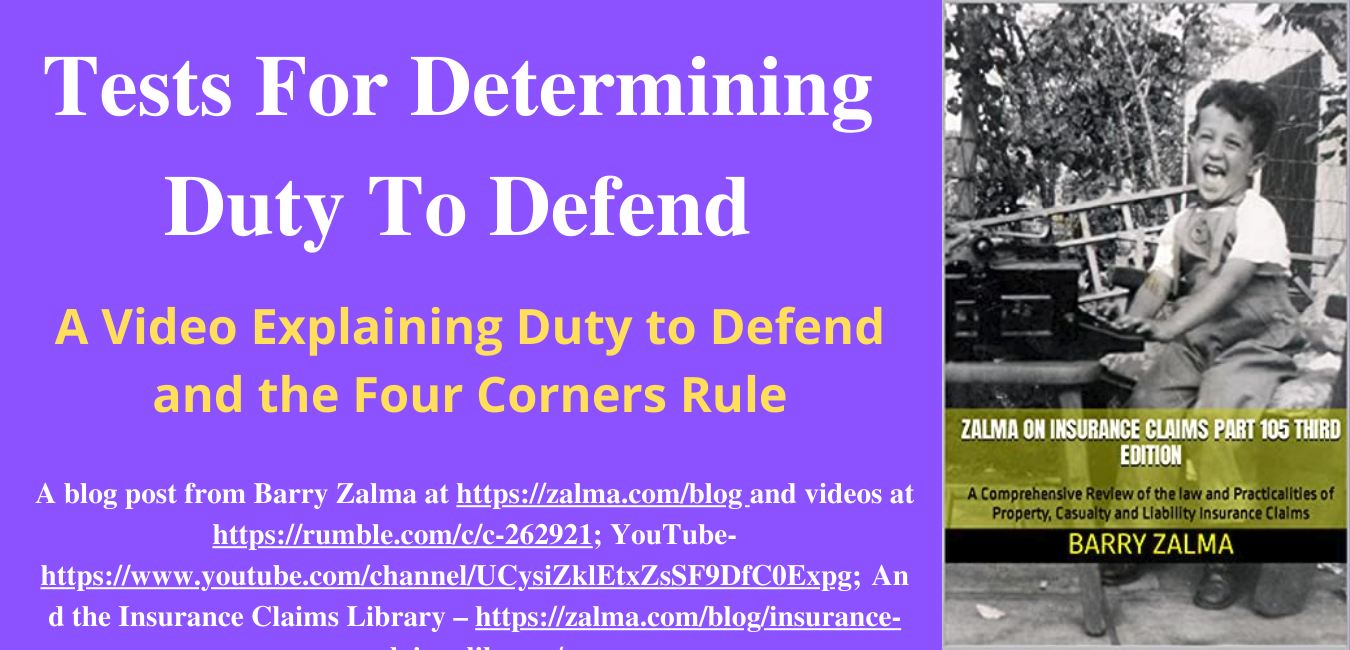Tests for Determining Duty to Defend

A Video Explaining Duty to Defend and the Four Corners Rule
Read the full article at https://www.linkedin.com/pulse/tests-determining-duty-defend-barry-zalma-esq-cfe and see the full video at https://rumble.com/c/c-262921 and at https://youtu.be/a6KfQ-sMIsA and at https://zalma.com/blog plus more than 3900 posts.
Some states apply a rule of interpretation of the duty to defend a liability claim by limiting their review to the facts alleged in the lawsuit and the wording of the insurance policy.
They refuse to consider any evidence extrinsic to the allegations of the suit.
If any of the allegations are potentially covered by the policy, the duty to defend is established. If none of the allegations in the complaint is potentially covered by the policy, the insurer can generally refuse to defend.
“Four corners” refers to the parameters of the policy; there is a variant test known as the “eight corners rule.” There is little difference between the two; they both take into consideration the four corners of the suit and the four corners of the policy.
Courts operating under the four corners or eight corners rule will not consider extrinsic facts or the potential for a suit drafted out of spite. The prudent insurer will, before making a decision, determine what rule or test is applied in the jurisdiction where the loss occurred.
The rationale behind the two rules is to require insurers to defend their insureds against all covered claims regardless of merit. Allowing an insurer to admit extrinsic evidence that contradicts a plaintiff’s allegations to establish the applicability of a policy exclusion would circumvent the very reason for the rules.52
Many jurisdictions have ruled that any doubt regarding the obligation to defend is to be resolved in favor of the insured [Miller v. Elite Ins. Co., 100 Cal. App. 3d 739 (1980)].
Potentiality
The insurer is not required to indemnify the insured if the potentiality of an accidental cause never materializes, if the jury finds that the insured intentionally caused the plaintiff’s injury, or if the insured is convicted of the crime of battery. However, even though a policy excludes liability arising from violations of law, there is the potentiality that the jury would find there was no violation of law and that the policy provided coverage. However, if the claims of negligence against the insured were potentially covered under the policy the insurer will have a duty to defend.
Determining whether insurance coverage exists requires analysis of the claims asserted in the state court action. [ Elec. & Power Co. v. Northbrook Prop. & Cas. Ins. Co., 475 S.E.2d 264, 265-66 (Va. 1996); Bohreer v. Erie Ins. Grp., 475 F. Supp. 2d 578, 584 (E.D. Va. 2007)] noting that Virginia recognizes the “potentiality rule.”
We are 100% funded for October.
Thanks to everyone who helped out. 🥰
Xephula monthly operating expenses for 2024 - Server: $143/month - Backup Software: $6/month - Object Storage: $6/month - SMTP Service: $10/month - Stripe Processing Fees: ~$10/month - Total: $175/month
- Art
- Causes
- Crafts
- Crime
- Dance
- Drinks
- Film
- Finance
- Fitness
- Food
- Spellen
- Gardening
- Health
- Home
- Literature
- Music
- Networking
- Paranormal
- Other
- Politics
- Bedrijvengids
- News
- Party
- Science
- Religion
- Shopping
- Sports
- SyFy
- Politically Incorrect
- Philosophy
- Theater
- Technology
- Wellness



